Chinese Name: 黄山 Pronunciation: Huáng Shān
Suggested Visiting Hours: 1-2 Days
Height: 1,864 meters (6,115 feet)
Mountain Tourist Area: 160.6 square kilometers
Address: Tangkou Town, Huangshan District, Huangshan Prefecture, Anhui Province, Eastern China
| Peak and Shoulder Season (January 21st – November 19th) |
Low Season (November 20th – January 20th) |
|
| Adult | 190 yuan | 150 yuan |
| Child (over 6 years old but under 18 years old) |
95 yuan | 75 yuan |
| Senior (over 60 years old but under 65 years old) |
95 yuan | 75 yuan |
Children under 6 years old or under 1.2m tall are free of charge;
Senior citizens over 65 years old (with ID card) are free of charge;
People with disabilities (with disability certificate) are free of charge;
There’s no time limit for staying inside once you enter the scenic area. So for visitors who want to spend more than one day here, they can choose to stay in a hotel or camp within the scenic area.
Visitors can also enter Mount Huangshan Scenic Area free of charge for the second time within three days from the first admission. Generally, when a tourist passes through the entrance for the first time with a ticket, ID card or QR code, the camera will automatically take a picture. When entering the scenic area for the second time, the visitor should show relevant ticket to the staff to retrieve the picture taken in the first admission, and then he or she is able to enter again after the confirmation.
| Peak and Shoulder Season (January 21st –November 19th) |
Low Season ( November20th – January 20th ) |
||
| Cable Car Ticket (one-way) |
Cloud Valley/Taiping | 80 yuan | 65 yuan |
| Jade Screen | 90 yuan | 75 yuan | |
| West Sea Valley | 100 yuan | 80 yuan | |
| March 2nd - October 31st | November 1st - March 1st | |
| Mount Huangshan Scenic Area | 6:20-17:30 from Monday to Friday; 6:00-17:30 on weekends and public holidays |
7:20-16:30 |
| Cable Car (the operational time will be announced separately on National Day holiday, on days with extreme weather and cableway maintenance) |
||
| Cloud Valley, Taiping, Jade Screen | 06:20 - 17:40 from Monday to Friday; 06:00 - 17:40 on weekends and public holidays | 07:20 - 16:40 |
| West Sea Valley | 08:00 - 17:00; closed from December to March annually for maintenance | |
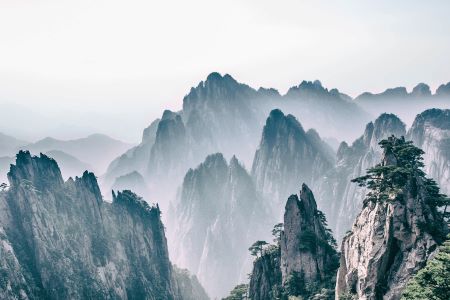
Located in Huangshan City, southern Anhui Province, Mount Huangshan was listed as a World Cultural and Natural Heritage Site by UNESCO in 1990 and was listed as the first batch of World Geological Park in 2004. As one of the ten famous mountains in China, it was also classified as a national 5A-level scenic spot by the China National Tourism Administration in 2007. With breathtaking natural landscapes, Mount Huangshan is considered as the symbol of Anhui tourism.
The Huangshan Mountains cover a total area of about 1,200 square kilometers, among which the Huangshan Scenic Area covers an area of 160.6 square kilometers. Divided into 9 small scenic areas, Huangshan Scenic Area begins at Huangshi in the east, ends at Xiaolingjiao in the west, with Erlongqiao in its north and Tangkou Town in the south.
Mount Huangshan is located in the subtropical monsoon climate zone, resulting in dense clouds, high humidity and heavy precipitation in this area. Because of the mild climate, Mount Huangshan is neither too hot in summer, nor too cold in winter.

The average annual precipitation on the top of the mountain is 2,369.3 mm, with an average annual rainy day of 180.6 days, mostly concentrated from April to June. In Mount Huangshan, the average annual temperature is 7.9℃; the highest temperature in summer is 27℃ while the lowest temperature in winter is -22℃. The air quality is good all year round by virtue of the dense trees and numerous streams in the area, and therefore, Mount Huangshan is also called a “natural oxygen bar”.
After the orogeny, crust uplift, glaciers and natural weathering, the beautiful and spectacular landscape of Mount Huangshan was formed. Mount Huangshan is composed of 72 peaks, among which Guangming (Brightness) Peak, Tiandu (Heavenly Capital) Peak and Lotus Peak are the three main peaks of Mount Huangshan.
Main scenic areas of Mount Huangshan include Hot Spring Scenic Area, Yuping (Jade Screen) Scenic Area, Baiyun (White Cloud) Scenic Area, Tianhai (Heavenly Sea) Scenic Area, Beihai (North Sea) Scenic Area, Xihai (West Sea) Scenic Area and Songgu (Pine Valley) Scenic Area.

The whole scenic area is divided into the front and the rearmountains. The front mountain is from Ciguang (Merciful Light) Pavilion to Guangming (Brightness) Peak, while the rear mountain is from Yungu (Cloud Valley) Temple to Guangming Peak, and each route has its own characteristics.
The representative landscapes of Mount Huangshan are “five wonders and three waterfalls”. The five wonders are odd-shaped pines, peculiar rocks, sea of clouds, hot springs and winter snow. The three waterfalls are Renzi (V Shape) Waterfall, Baizhang Spring and Jiulong (Nine-Dragon) Waterfall.
Xu Xiake, a famous Chinese geologist of the Ming Dynasty, traveled here for twice and he eulogized the captivating scenery of Mount Huangshan by saying that, “After seeing ‘the Five Mountains’ (Mount Taishan, Mount Huashan, Mount Hengshan in Shanxi Province, Mount Songshan, and Mount Hengshan in Hunan Province), you don't need to see any more mountains, and after seeing Huangshan you don't need to see the other four mountains.”
“Huangshan Five Wonders” refers to the five unique landscapes of Mount Huangshan, namely peculiar pines, oddly-shaped rocks, sea of clouds, hot spring and winter snow.
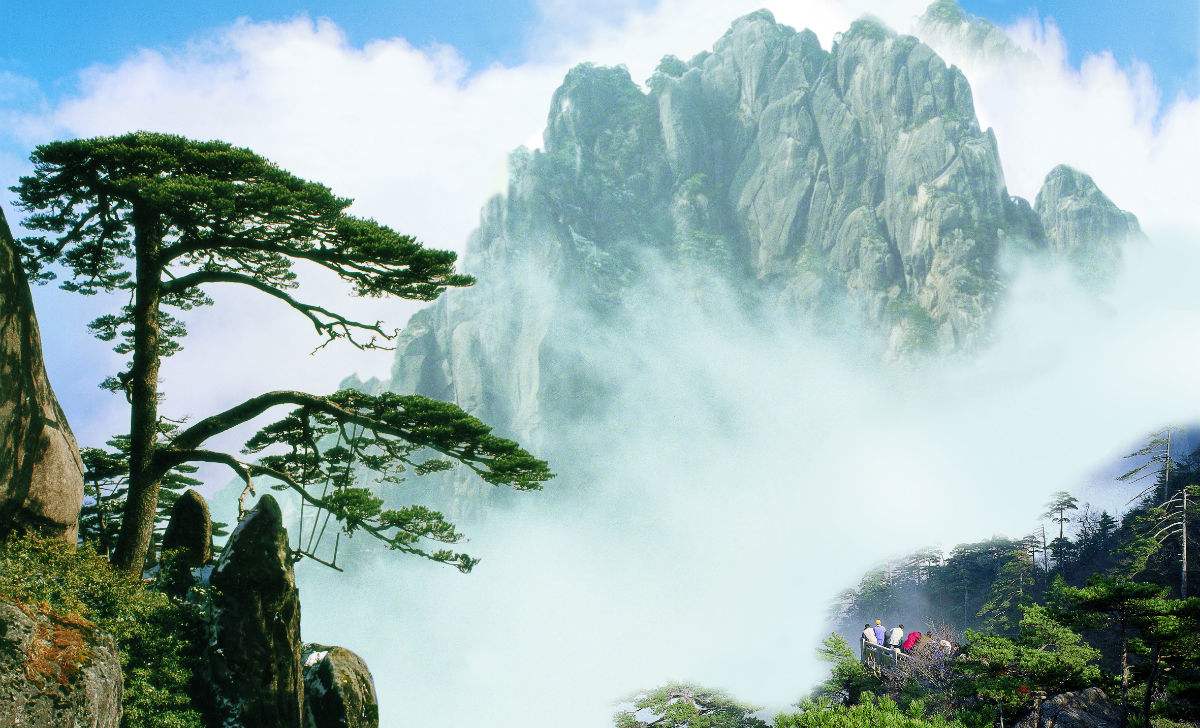
There are varieties of pines at Mount Huangshan, most of which are named according to their shapes or some legends about them. The top ten pines at Mount Huangshan include Guest-Welcoming Pine, Farewell Pine, Black Tiger Pine, Loving Couple Pine, Sea Exploring Pine, Harp Pine, Putuan Pine (Zafu Pine), Qilin Pine (qilin is a mythical creature in Chinese), Dragon’s Claw Pine, and Leading Pine, among which the most famous one is the Guest-Welcoming Pine.
Guest-Welcoming Pine, a 10-meter (33 feet) high tree that was formed over 1,300 years ago, is situated at Jade Screen Pavilion. It received its name for the shape of the tree, which is like a man stretching out his arms to welcome guests from afar. It has not only become a symbol of the hospitality of Huangshan people but also the symbol of peace and friendship between Chinese people and people from all over the world.
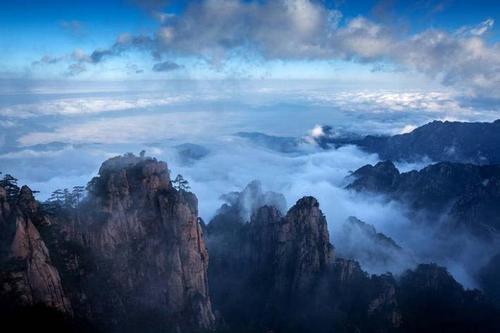
There are more than 120 oddly-shaped rocks with names at Mount Huangshan, which were formed in Quaternary Glacier Period more than 1 million years ago. Some representative oddly-shaped rocks include A Flower on the Brush Tip, Flying-over Rock, and Stone Monkey Gazing over the Sea of Clouds, and so on.

Since ancient times, Mount Huangshan has been famous for its sea of clouds, which could be seen all year round, especially in winter. According to the distribution of clouds, seas of clouds at Mount Huangshan could be divided into East Sea, South Sea, West Sea, North Sea and the Heavenly Sea.
A sea of clouds will form when the water vapor rises or the fog does not disappear after the rainfall. In late autumn, patches of red leaves float on the sea of clouds, creating a picturesque and breathtaking landscape at Mount Huangshan. When the clouds pass through the two peaks of the Double Shear Peak, it looks like a magnificent waterfall pouring down the mountain.
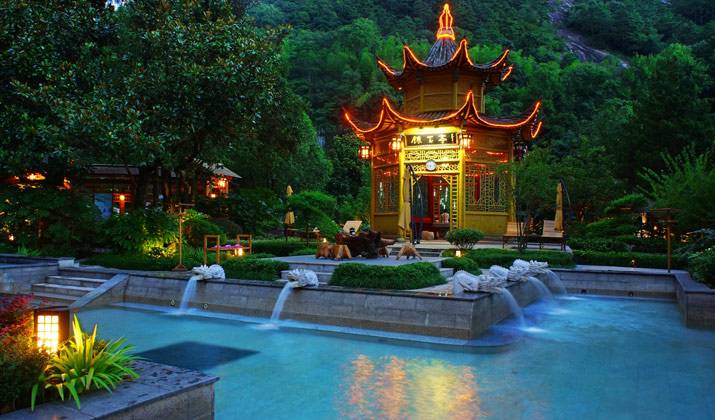
The hot springs of Mount Huangshan originate from the Purple Cloud Peak, 850 meters above the sea level. Rich in bicarbonate, the water is drinkable and can be used for bathing. It is said that having bathed in the hot spring at Mount Huangshan for 49 days, the Yellow Emperor Xuanyuan, who is considered as the ancestor of the Chinese nation, regained his youth and successfully ascended to the heaven. And therefore hot springs at Mount Huangshan are also known as “the Springs of Youth”.
The hot springs of Mount Huangshan produce about 400 tons of water every day, and the water temperature is about 42℃ all year round. It has certain effects on some diseases of the digestive system, nervous system, cardiovascular system, metabolism system and exercise system. Besides, it is also helpful for the prevention and treatment of skin diseases.
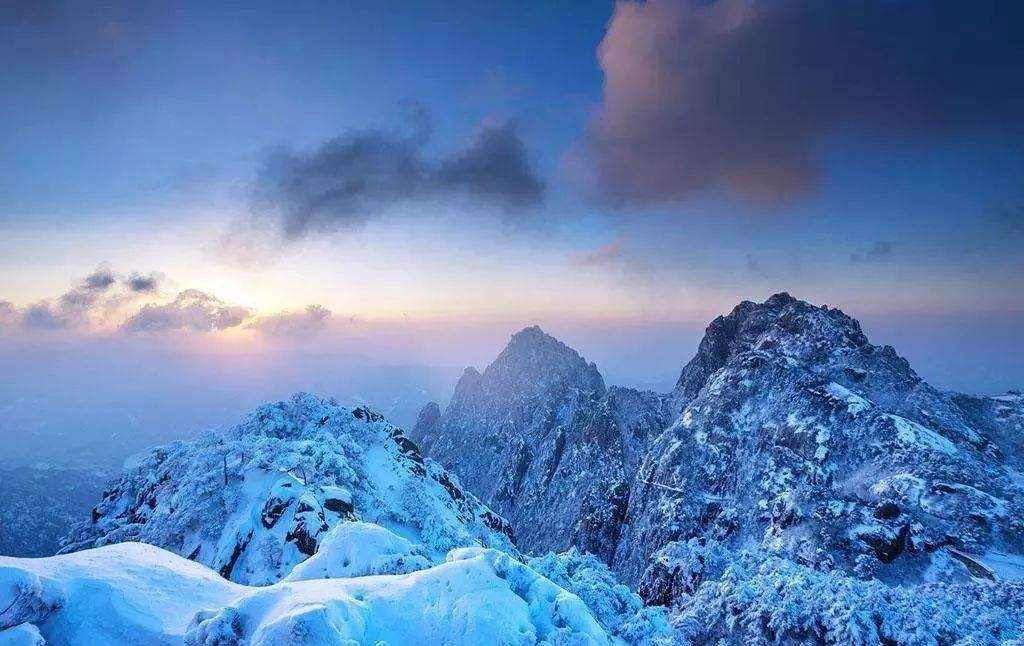
Winter is a good time to take pictures of Mount Huangshan. In winter, trees are covered by rime and the oddly-shaped rocks lying on the snow are even more rugged and peculiar. When the sun shines on the snow, the mountains start to glitter and the Mount Huangshan looks like a silver world that only exists on fairy tales. Snow scenery has been listed as one of the five wonders of Mount Huangshan.

Located at the front range of Mount Huangshan Scenic Area, Jade Screen Scenic Area gathers some of the most breathtaking landscapes of Mount Huangshan including One-Line Sky, 100-step Scaling Ladder, Turtle Cave, etc.
Jade Screen Pavilion sits between Lotus Peak and Heavenly Capital Peak, the two main peaks of Mount Huangshan. It is the best place to appreciate the natural wonders of Mount Huangshan. On the left side of Jade Screen Pavilion is the Guest-Welcoming Pine, while on the right side stands the Farewell Pine.
Behind the Yuping building is Jade Screen Peak, where the Reclining Buddha is on the top. Its head and left foot lies on the right side. Besides, Jade Screen Peak is also famous for the stone inscriptions by Chairman Mao Zedong, Marshal Zhu De, and Marshal Liu Bocheng, which eulogize the enchanting and splendid scenery of Mount Huangshan.
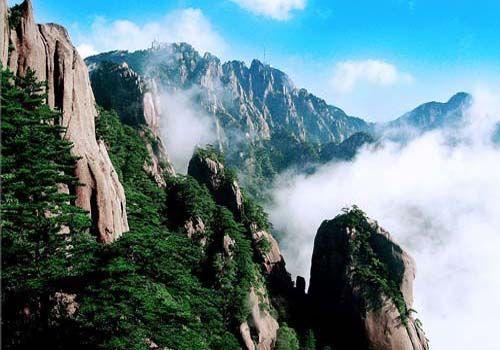
Heavenly Capital Peak is the most precipitous one among the three main peaks of Mount Huangshan, rising about 1,800 meters above sea level. It is named “Heavenly Capital Peak(Tiandu-the capital of heaven Peak)” since it looks as mysterious and majestic as the capital of heaven while surrounded by mist. Although it is not the highest peak of Mount Huangshan, it could still be considered as the most representative one for its magnificence.
Heavenly Capital Peak is the ideal place to have a panoramic view of Mount Huangshan. That’s why people say that it would be a waste of time visiting Mount Huangshan if you don’t surmount the Heavenly Capital Peak. In ancient times, there was no way to ascend to Tiandu Peak, and only a few people were able to climb it.
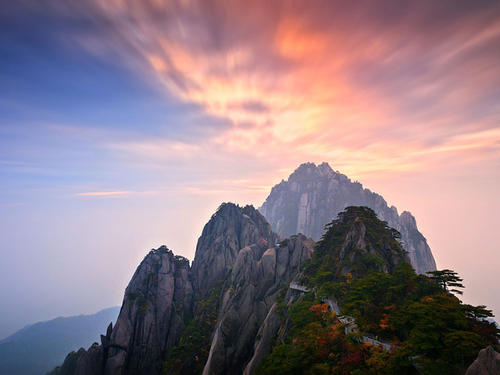
Located in the north of Jade Screen Pavilion, Lotus Peak is the highest peak at Mount Huangshan, with an elevation of 1864.8 meters. It is about 1.5 kilometers from Lotus Ridge to Lotus Peak, along which are some famous pines like the Flying Dragon Pine, Hanging-Upside-Down Pine and Huangshan rhododendrons.

Surrounded by Shixin Peak, Lion Peak and White Goose (Bai'e) Peak, North Sea (Beihai) Scenic Area is the central part of Mount Huangshan Scenic Area, bordering Cloud Valley (Yungu) Scenic Area in the east, Jade Screen Scenic Area in the south and Pine Valley (Songgu) Scenic Area in the north.
With an altitude of about 1,600 meters above sea level, it is a highland scenic area covering an area of 1,316 hectares. Lion Peak at an altitude of 1,690 meters and Refreshing Terrace (Qing Liang Tai) are located here. Additionally, Refreshing Terrace is thought to be the best place to watch the sea of clouds and sunrise.
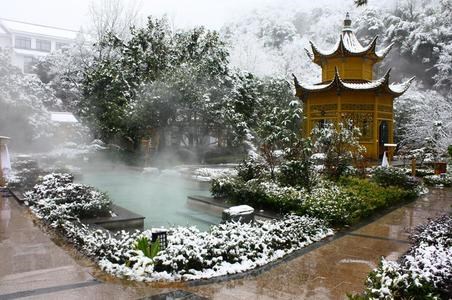
Hot Spring Scenic Area was called “the Wonderland of Peach Blossoms” in ancient times with an elevation of above 650 meters and now it is one of the reception centers for Mount Huangshan Scenic Area.
Hot Spring Scenic Area is the transportation hub leading to the south gate and the scenic spots in the mountains. Some main scenic spots in this area are Lansheng Bridge, Merciful Light (Ciguang) Pavilion, Yiran Pavilion, Hot Spring, Watching Waterfall (Guanpu) Pavilion, Baizhang Spring, V Shape (Renzi) Waterfall and so on.

White Cloud (Baiyun) Scenic Area is located in the west of Mount Huangshan, covering an area of 16.5 square kilometers. Fishing Bridge (Diaoqiao) Temple is the center in this area.
After passing through Fishing Bridge Temple, visitors can reach Sanhekou, the confluence of three streams flowing from Nine-Dragon Peak, Cloud Dispersing (Paiyun) Pavilion and the Heavenly Sea, where visitors could watch the highest waterfall at Mount Huangshan.
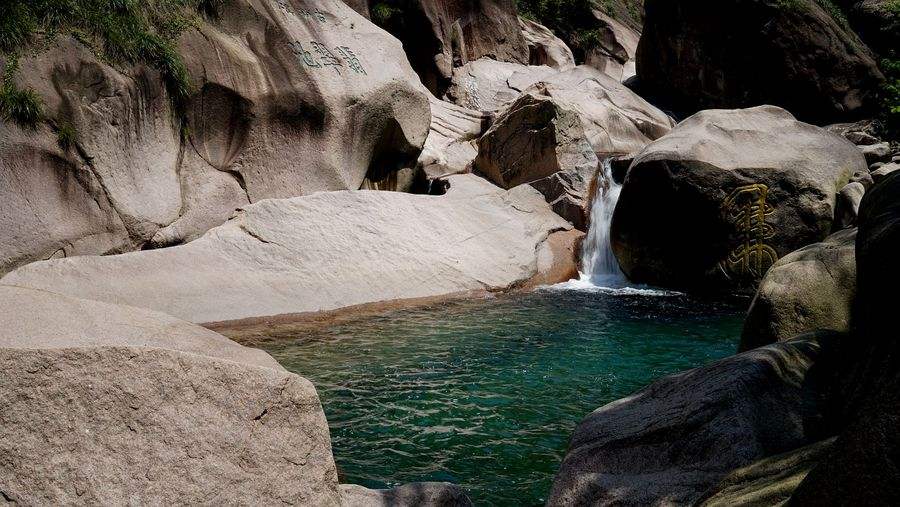
Pine Valley (Songgu) Scenic Area, a general term for valleys among Lion Peak, Camel Peak, Bookcase Peak and Pagoda Peak, is located on the northern slope of Mount Huangshan. Visiting Pine Valley Scenic Area, one could see peaks such as Danxia Peak, Pine Forest Peak, oddly-shaped rocks such as Reclining Tiger Rock, the Sea of Clouds, ancient architectures such as Lotus Pavilion, Pine Valley Temple, and ponds such as the Emerald Pool, the Five-Dragon Pond, etc.
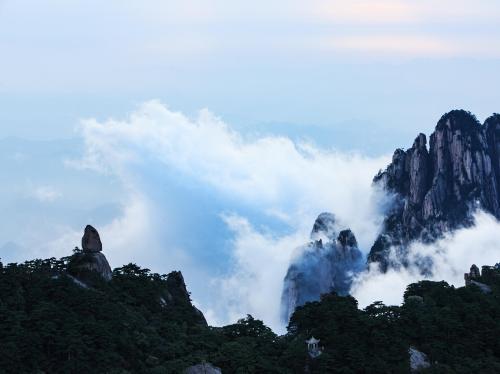
Cloud Valley (Yungu) Scenic Area is located in the east of Mount Huangshan, with an altitude of only 890 meters above sea level. Cheng Yuanfeng, the prime minister (in feudal China) of the Song Dynasty, once studied here, and therefore Cloud Valley Scenic Area is also known as “the Land of Prime Minister”. The main scenic spots in Cloud Valley Scenic Area include Cloud Valley Temple, Nine-Dragon Waterfall, oddly-shaped rocks, etc.
Day 1
South Gate Interchange - Yungu Temple - Yungu Ropeway - Stalagmite Bridge - Shixin Peak - Black Tiger Pine - Beihai Hotel – Refreshing Terrace - Stone Monkey Gazing over the Sea of Clouds - Lion Peak - Stone Monkey Gazing over the Sea of Clouds – Refreshing Terrace - Lion Forest Hotel - Xihai Hotel – Paiyun Pavilion - Xihai Grand Canyon - Cable Car – Rock Bed Peak - Baiyun Hotel or Guangmingding Guesthouse (drop your bags) - Wolling Stone Phiyun - Bu Xian Bridge - Wolling Stone Phiyun - Baiyun Hotel – Guangming Peak (watch the sunset) - Baiyun Hotel or Guangming Peak Guesthouse (rest)
Day 2
Baiyun Guesthouse or Guangmingding Guesthouse – Guangming Peak (watch the sunrise) - Baiyun Guesthouse (check out) - Haixin Pavilion - One-Line Sky - Hundred Paces Ladder - Guest-Welcoming Pine - Lotus Peak - Tiandu Peak - Banshan Temple – Ciguang Pavilion - South Gate Interchange
Best places to appreciate the sunrise: Refreshing Terrace, Shuguang Pavilion, Lion Peak, Begin-to-believe Peak, Danxia Peak, Bright Top Peak, Turtle Peak, and Yu Ping Lou (Jade Screen Building).
Best places to appreciate the sunset: Paiyun Pavilion (Cloud Dispersing Pavilion), Danxia Peak, Fly Over Stone, Guangming Top, and Lion Peak.
Best places to appreciate the sea of clouds: Jade Screen Building for Front Sea, Refreshing Terrace for Back Sea, Bai’e Ling (White Goose Ridge) for East Sea, Cloud Dispersing Pavilion for West Sea, and Bright Top Peak for the Heavenly Sea.
Best places to appreciate the snow scenery: Bei Hai (North Sea) Scenic Area, Xi Hai (West Sea) Scenic Area, Tian Hai (Heavenly Sea) Scenic Area, Jade Screen Building, Song Gu (Pine Valley) Scenic Area, Yun Gu (Cloud Valley) Scenic Area and Hot Spring Scenic Area.
Being situated in the subtropics, Mount Huangshan is worth visiting all the year round by virtue of the clear seasonal divisions. There are more people in summer and autumn, followed by winter and spring.
In spring, hundreds of flowers are blooming in profusion at Mount Huangshan, creating the colorful and attractive scenery that is as beautiful as a painting. On both sides of the road leading to Mount Huangshan, the fields are full of golden rape flowers. The mountains are dotted with pink and green since the peach trees are in full blossom and the grasses have just sprouted.
In summer, Mount Huangshan is a good place to escape the summer heat. The mountains are verdant and green reverberating with the singing of birds. The average temperature at Mount Huangshan in summer is 20.7℃, and the average temperature at the top of the mountain is only 18.7℃. It is an ideal summer resort because it is cool during the day, and one can sleep well with a light quilt at night. Summer is the peak season of Mount Huangshan because of the summer vacation. And one should book a hotel room in advance and it is more likely that one has to spend a long time waiting for a cable car.
Mid-October is the best time for tourists to appreciate the colorful autumn leaves at Mount Huangshan. Xu Xiake, a great traveler in the Ming Dynasty, once praised the autumn at Mount Huangshan was rich in color and as splendid as embroidery, with maples and pine intertwining and reflecting each other. The clear and rainless weather with comfortable temperatures between 18℃ and 27℃ makes autumn, especially from early September to mid-October, the best time of a year to visit Mount Huangshan for general outdoor activities.
Snow scenery has been listed as one of the five wonders of Mount Huangshan, making winter one of the most popular seasons to visit Mount Huangshan. The winter of Mount Huangshan comes early and lasts long. What makes the winter of Mount Huangshan worthy of visiting is rime. It is neither snow nor frost, but it is more beautiful than snow and frost. It seems that the mountains are dotted with silver trees and flowers when winter comes.
Please pay attention that the temperature at Mount Huangshan sometimes varies greatly between day and night, and therefore one should take a light coat especially in autumn.
Mount Huangshan is located in Huangshan District, Huangshan City. As one of the most important tourist attractions in China, the transportation in Huangshan City is quite convenient. Huangshan City ownsan airport, which is a national first-class airport. Tourists could go to Huangshan City by air, by train, or by long-distance bus and then transfer to Mount Huangshan Scenic Area by bus or taxi.
a. From Huangshan North Railway Station to Mount Huangshan Scenic Area
You can take the regular buses from Huangshan North Railway Station to the Mount Huangshan Scenic Area. And the following information is as follow:
| Route | Departure Time | Fare |
| Huangshan North Railway Station → the South Gate of Mount Huangshan Scenic Area | 8:30, 9:30, 10:20, 10:50, 11:20, 12:00, 13:00, 13:20, 13:40, 14:20, 14:40, 15:30, 16:40, 17:30, 18:30 | 20 yuan |
| Huangshan North Railway Station → the North Gate of Mount Huangshan Scenic Area | 11:30, 16:00 | 50 yuan |
| Huangshan North Railway Station → the West Gate of Mount Huangshan Scenic Area | 12:50 | 39 yuan |
It takes about 2 hours to go to Mount Huangshan Scenic Area from Huangshan North Railway Station by bus.
b. From Huangshan Railway Station to Mount Huangshan Scenic Area
Take bus 21 to Huangshan North Railway Station and then take the regular buses to Mount Huangshan Scenic Area. It takes about 2 hours and 45 minutes to go to Mount Huangshan Scenic Area from Huangshan Railway Station by bus.
c. From Huangshan Tunxi International Airport to Mount Huangshan Scenic Area
There is no direct bus from the airport to Mount Huangshan Scenic Area. If you want to go to Mount Huangshan Scenic Area by bus, you should first take bus 218 at Airport Station, and get off at Library Square Station (the third station). And then, take bus 3 at Library Square Station and get off at the sixth station—Huangshan North Railway Station. There are regular buses to Mount Huangshan Scenic Area in Huangshan North Railway Station. It takes about 3 hours to go to Mount Huangshan Scenic Area from Huangshan Tunxi International Airport by bus.
Chinese: 请带我去黄山。English: Please take me to Mount Huangshan.
If you want to go to Mount Huangshan Scenic Area by taxi, it takes about 180 yuan and about 55 minutes from Huangshan North Railway Station.
If you want to go to Mount Huangshan Scenic Area by taxi, it takes about 180~200 yuan and about 1 hour from Huangshan Railway Station.
If you want to go to Mount Huangshan Scenic Area by taxi, it takes about 180~200 yuan and about 1 hour from Huangshan Tunxi International Airport.
